Abstract
Amebic keratitis produced by Acanthamoeba spp. is an increasingly important ocular infection in extended-use contact lens wearers. Problems associated with the infection are compounded by the lack of effective and well-tolerated chemotherapeutic agents. The magainins, a group of naturally occurring and synthetic membrane-active peptide compounds, have been shown to be active in vitro against a clinical isolate of Acanthamoeba polyphaga. Two magainins tested extensively had minimal inhibitory and minimal amebicidal values of 20 and 25 micrograms/ml for magainin MSI-103 and 25 and 40 micrograms/ml for magainin MSI-94, respectively. Both amebastatic and amebicidal activities are enhanced by combining the magainins with silver nitrate (200 micrograms/ml) and/or other marginally effective antimicrobial agents. These combinations have activity against both trophic and cystic stages in the Acanthamoeba life cycle and have promise as antimicrobial agents in the treatment of amebic keratitis.
Full text
PDF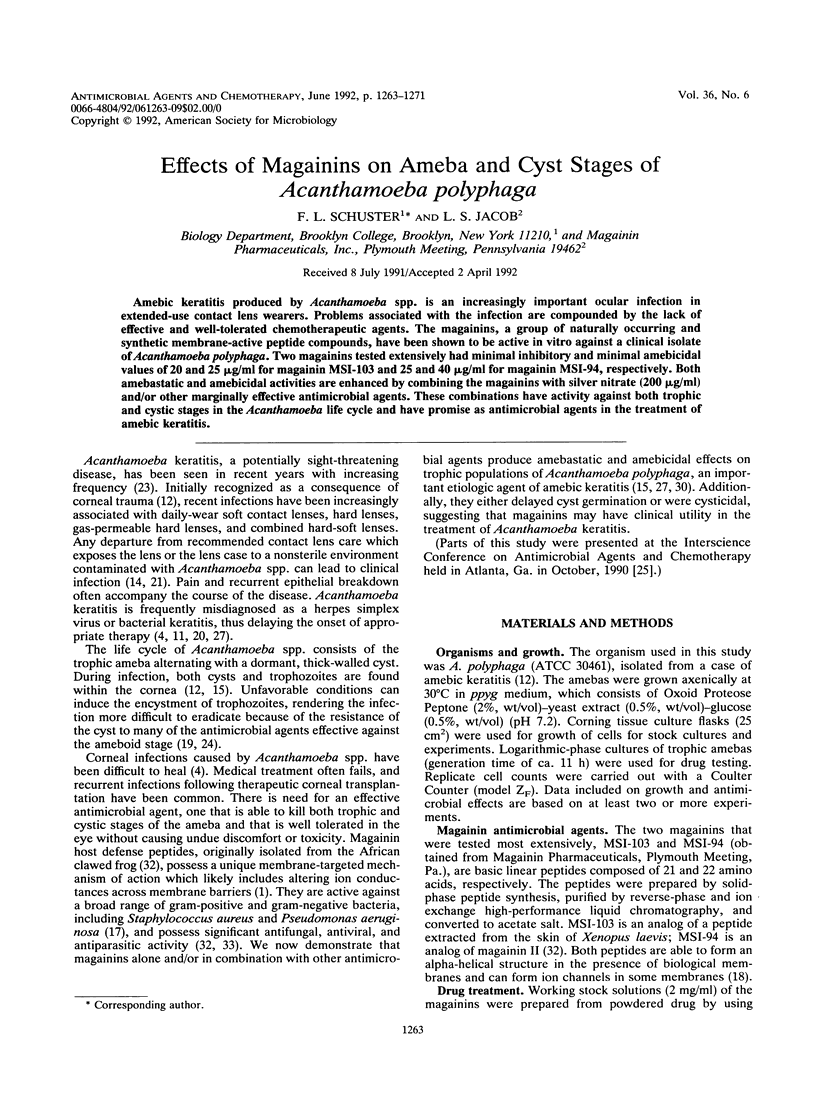
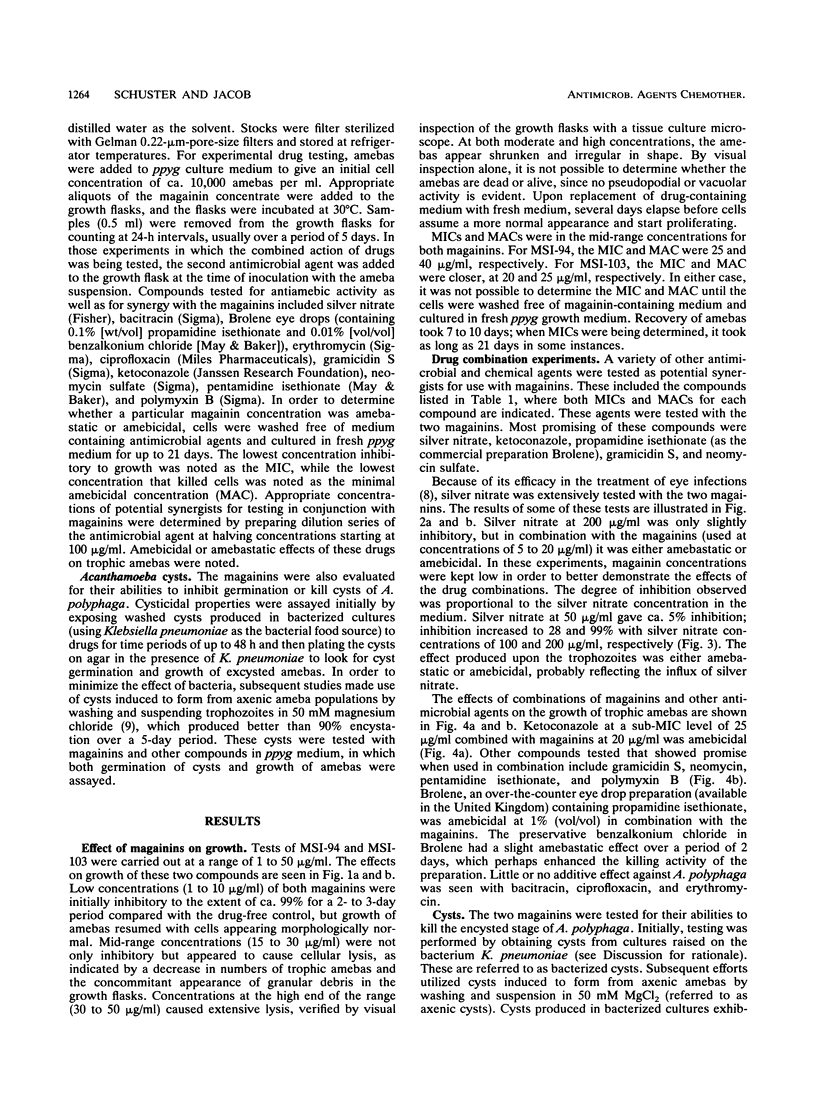
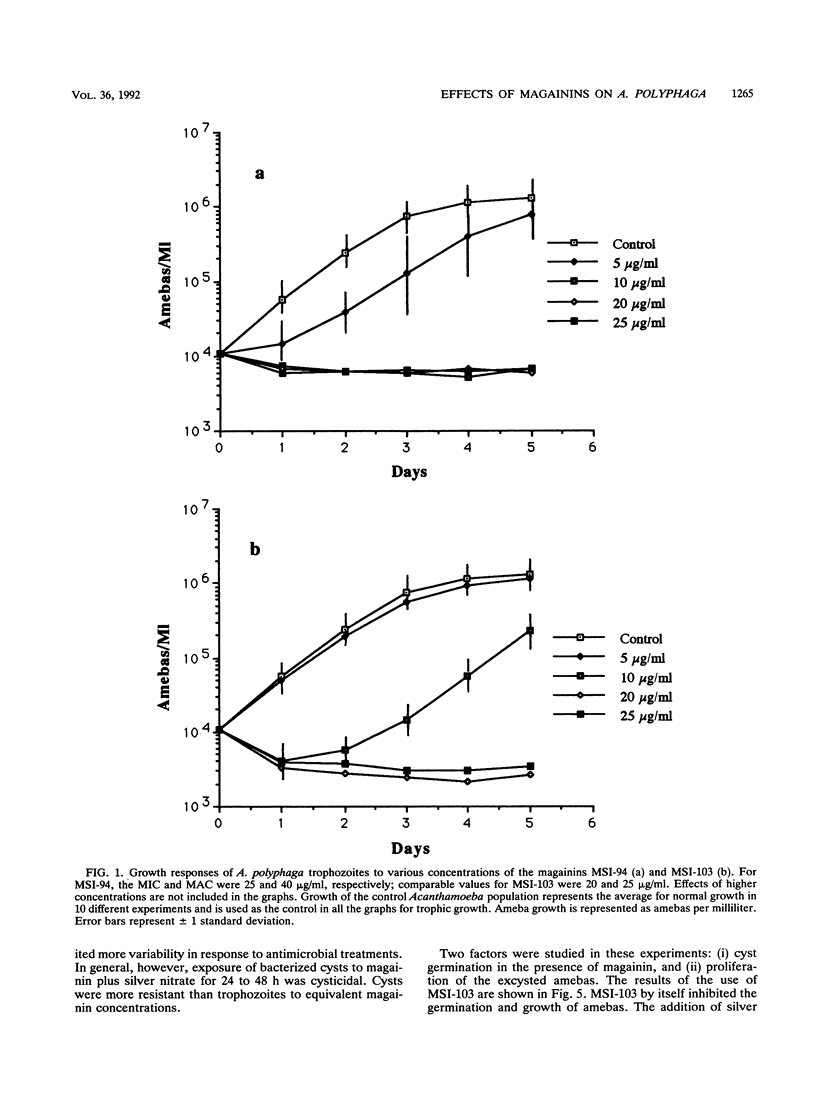
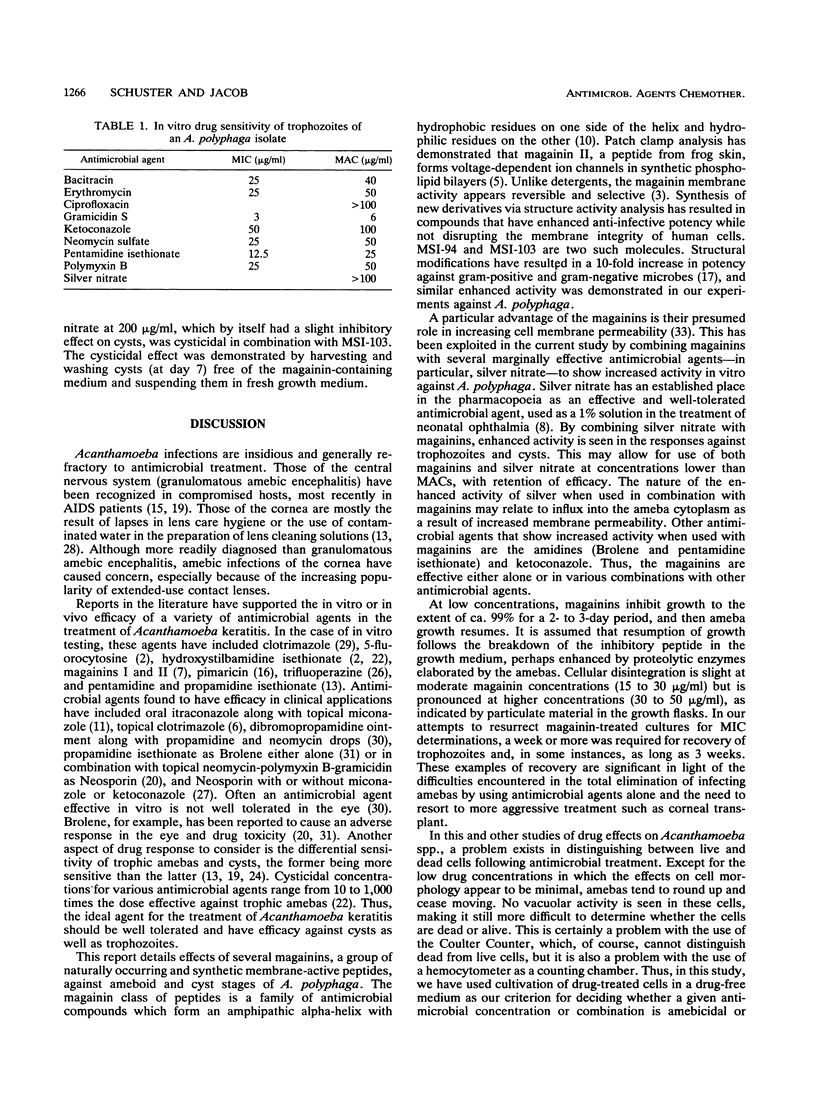
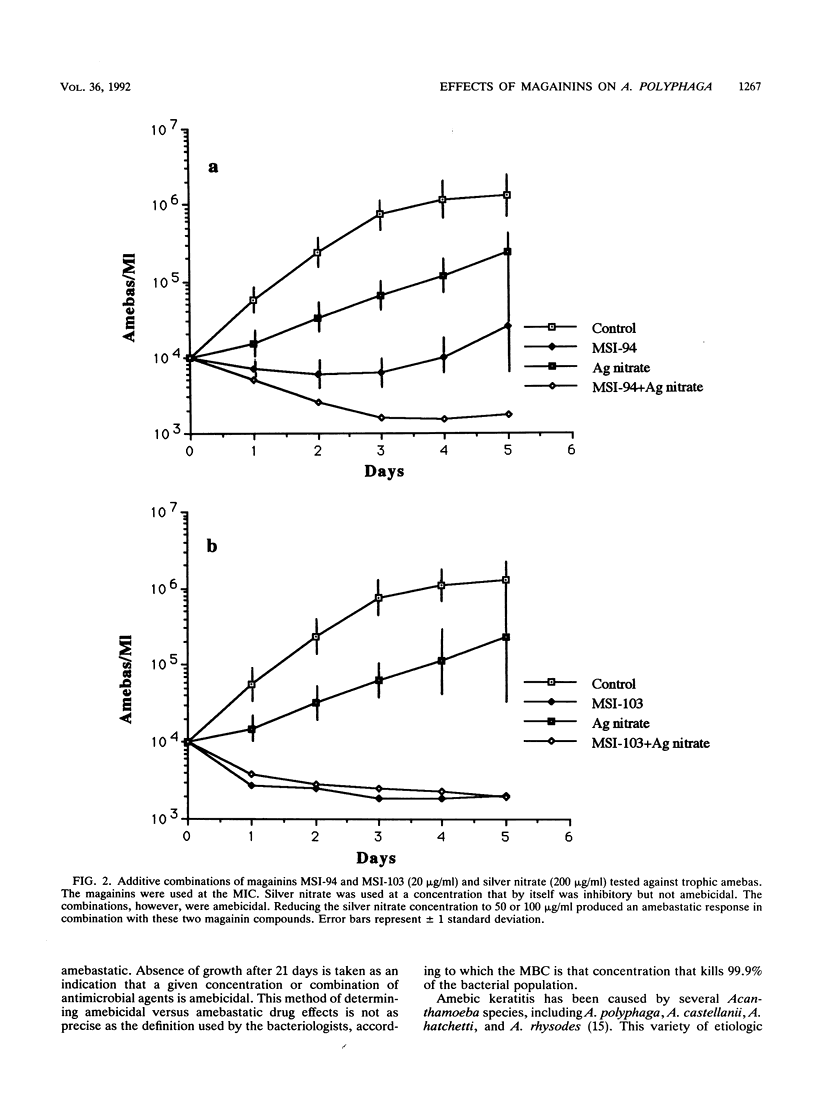
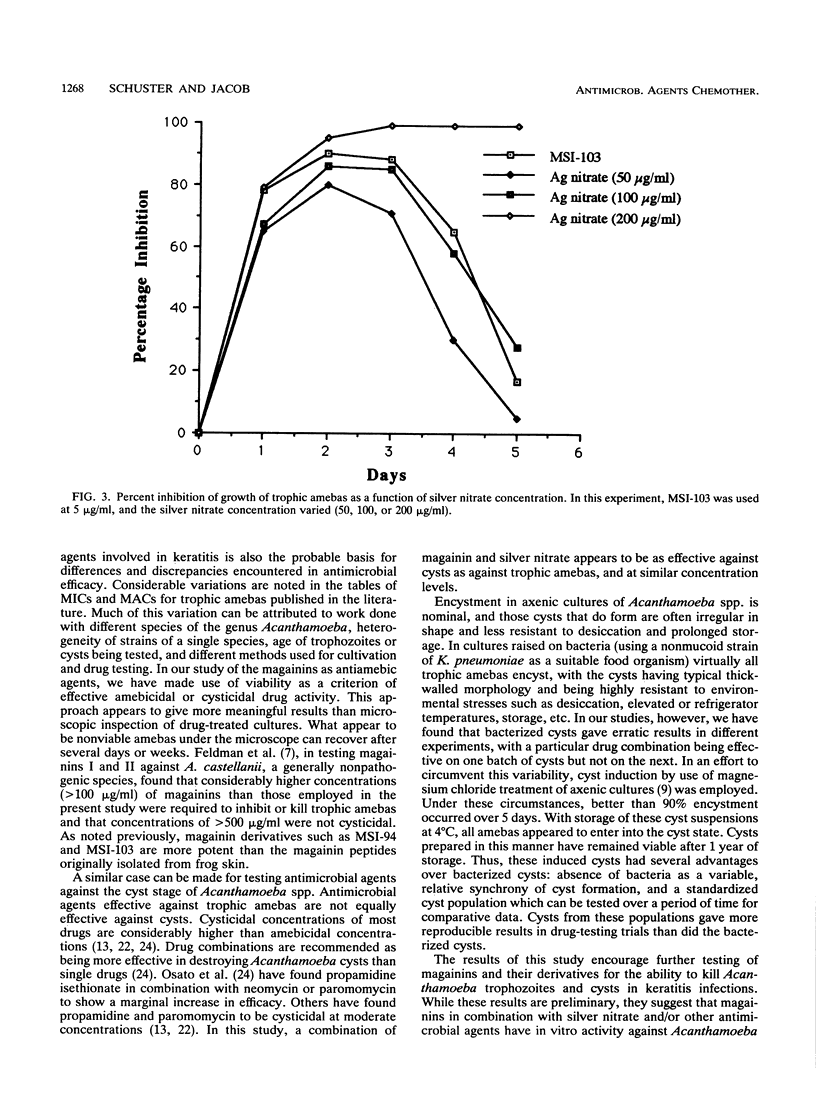
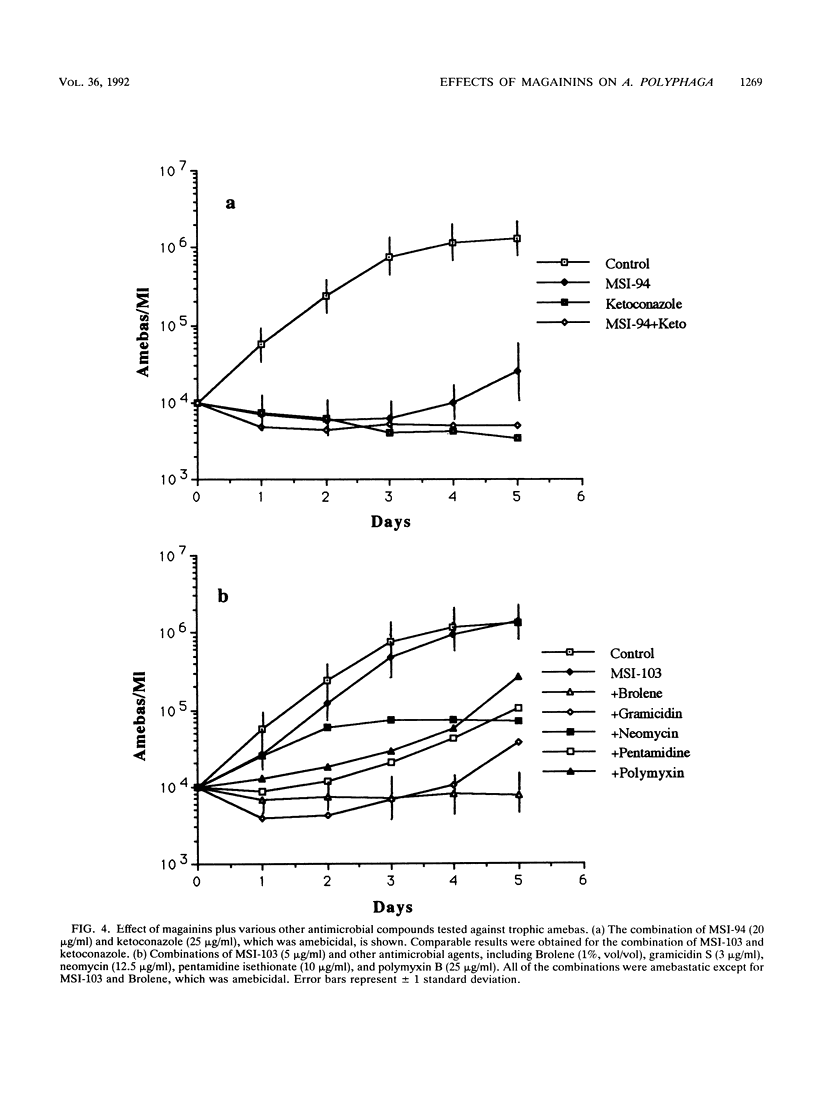
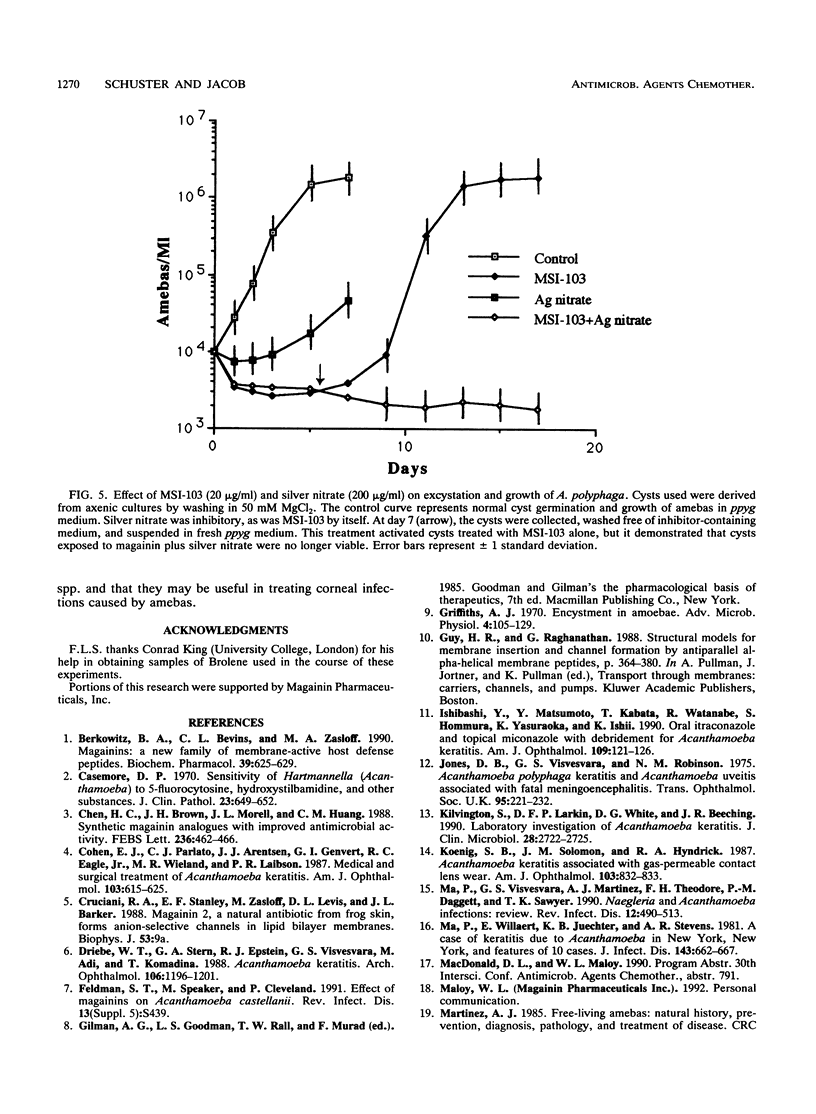
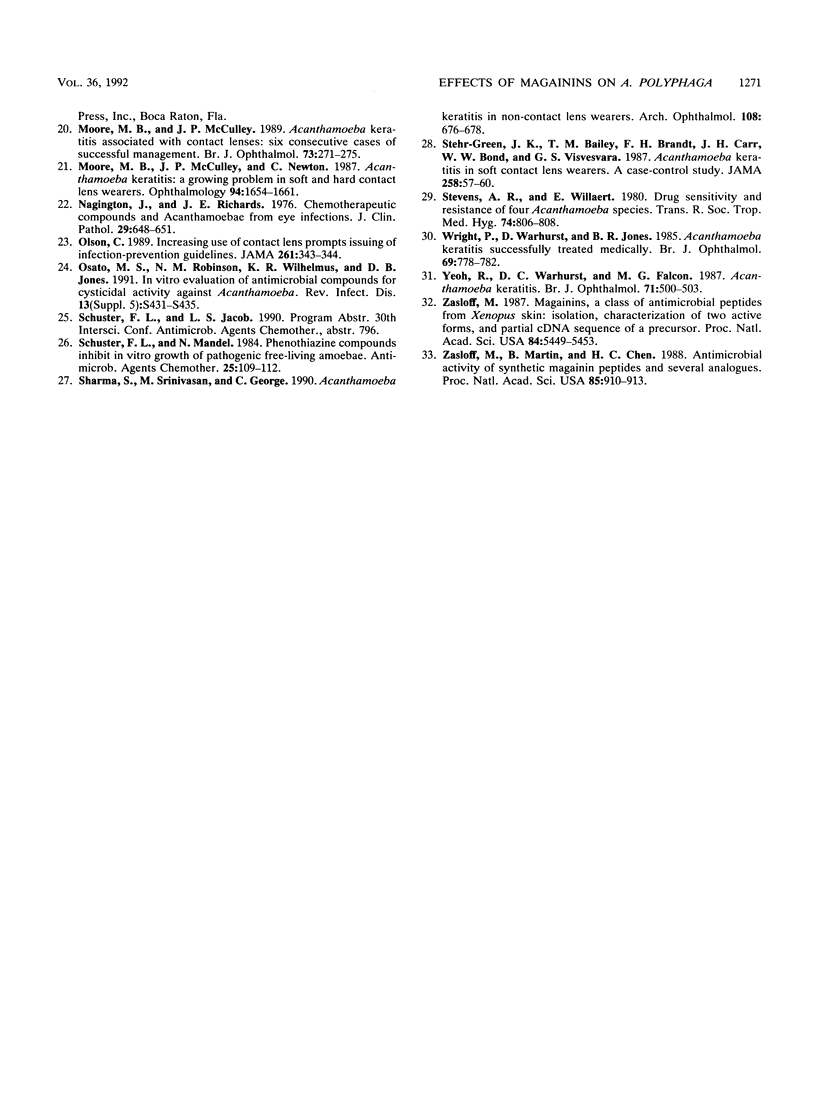
Selected References
These references are in PubMed. This may not be the complete list of references from this article.
- Berkowitz B. A., Bevins C. L., Zasloff M. A. Magainins: a new family of membrane-active host defense peptides. Biochem Pharmacol. 1990 Feb 15;39(4):625–629. doi: 10.1016/0006-2952(90)90138-b. [DOI] [PubMed] [Google Scholar]
- Casemore D. P. Sensitivity of Hartmannella (Acanthamoeba) to 5-fluorocytosine, hydroxystilbamidine, and other substances. J Clin Pathol. 1970 Nov;23(8):649–652. doi: 10.1136/jcp.23.8.649. [DOI] [PMC free article] [PubMed] [Google Scholar]
- Chen H. C., Brown J. H., Morell J. L., Huang C. M. Synthetic magainin analogues with improved antimicrobial activity. FEBS Lett. 1988 Aug 29;236(2):462–466. doi: 10.1016/0014-5793(88)80077-2. [DOI] [PubMed] [Google Scholar]
- Cohen E. J., Parlato C. J., Arentsen J. J., Genvert G. I., Eagle R. C., Jr, Wieland M. R., Laibson P. R. Medical and surgical treatment of Acanthamoeba keratitis. Am J Ophthalmol. 1987 May 15;103(5):615–625. doi: 10.1016/s0002-9394(14)74320-x. [DOI] [PubMed] [Google Scholar]
- Driebe W. T., Jr, Stern G. A., Epstein R. J., Visvesvara G. S., Adi M., Komadina T. Acanthamoeba keratitis. Potential role for topical clotrimazole in combination chemotherapy. Arch Ophthalmol. 1988 Sep;106(9):1196–1201. doi: 10.1001/archopht.1988.01060140356031. [DOI] [PubMed] [Google Scholar]
- Feldman S. T., Speaker M., Cleveland P. Effect of magainins on Acanthamoeba castellanii. Rev Infect Dis. 1991 Mar-Apr;13 (Suppl 5):S439–S439. doi: 10.1093/clind/13.supplement_5.s439. [DOI] [PubMed] [Google Scholar]
- Ishibashi Y., Matsumoto Y., Kabata T., Watanabe R., Hommura S., Yasuraoka K., Ishii K. Oral itraconazole and topical miconazole with débridement for Acanthamoeba keratitis. Am J Ophthalmol. 1990 Feb 15;109(2):121–126. doi: 10.1016/s0002-9394(14)75974-4. [DOI] [PubMed] [Google Scholar]
- Jones D. B., Visvesvara G. S., Robinson N. M. Acanthamoeba polyphaga keratitis and Acenthamoeba uveitis associated with fatal meningoencephalitis. Trans Ophthalmol Soc U K. 1975 Jul;95(2):221–232. [PubMed] [Google Scholar]
- Kilvington S., Larkin D. F., White D. G., Beeching J. R. Laboratory investigation of Acanthamoeba keratitis. J Clin Microbiol. 1990 Dec;28(12):2722–2725. doi: 10.1128/jcm.28.12.2722-2725.1990. [DOI] [PMC free article] [PubMed] [Google Scholar]
- Koenig S. B., Solomon J. M., Hyndiuk R. A., Sucher R. A., Gradus M. S. Acanthamoeba keratitis associated with gas-permeable contact lens wear. Am J Ophthalmol. 1987 Jun 15;103(6):832–832. doi: 10.1016/s0002-9394(14)74405-8. [DOI] [PubMed] [Google Scholar]
- Ma P., Visvesvara G. S., Martinez A. J., Theodore F. H., Daggett P. M., Sawyer T. K. Naegleria and Acanthamoeba infections: review. Rev Infect Dis. 1990 May-Jun;12(3):490–513. doi: 10.1093/clinids/12.3.490. [DOI] [PubMed] [Google Scholar]
- Ma P., Willaert E., Juechter K. B., Stevens A. R. A case of keratitis due to Acanthamoeba in New York, New York, and features of 10 cases. J Infect Dis. 1981 May;143(5):662–667. doi: 10.1093/infdis/143.5.662. [DOI] [PubMed] [Google Scholar]
- Moore M. B., McCulley J. P. Acanthamoeba keratitis associated with contact lenses: six consecutive cases of successful management. Br J Ophthalmol. 1989 Apr;73(4):271–275. doi: 10.1136/bjo.73.4.271. [DOI] [PMC free article] [PubMed] [Google Scholar]
- Moore M. B., McCulley J. P., Newton C., Cobo L. M., Foulks G. N., O'Day D. M., Johns K. J., Driebe W. T., Wilson L. A., Epstein R. J. Acanthamoeba keratitis. A growing problem in soft and hard contact lens wearers. Ophthalmology. 1987 Dec;94(12):1654–1661. [PubMed] [Google Scholar]
- Nagington J., Richards J. E. Chemotherapeutic compounds and Acanthamoebae from eye infections. J Clin Pathol. 1976 Jul;29(7):648–651. doi: 10.1136/jcp.29.7.648. [DOI] [PMC free article] [PubMed] [Google Scholar]
- Olson C. M. Increasing use of contact lenses prompts issuing of infection-prevention guidelines. JAMA. 1989 Jan 20;261(3):343–344. [PubMed] [Google Scholar]
- Osato M. S., Robinson N. M., Wilhelmus K. R., Jones D. B. In vitro evaluation of antimicrobial compounds for cysticidal activity against Acanthamoeba. Rev Infect Dis. 1991 Mar-Apr;13 (Suppl 5):S431–S435. doi: 10.1093/clind/13.supplement_5.s431. [DOI] [PubMed] [Google Scholar]
- Schuster F. L., Mandel N. Phenothiazine compounds inhibit in vitro growth of pathogenic free-living amoebae. Antimicrob Agents Chemother. 1984 Jan;25(1):109–112. doi: 10.1128/aac.25.1.109. [DOI] [PMC free article] [PubMed] [Google Scholar]
- Sharma S., Srinivasan M., George C. Acanthamoeba keratitis in non-contact lens wearers. Arch Ophthalmol. 1990 May;108(5):676–678. doi: 10.1001/archopht.1990.01070070062035. [DOI] [PubMed] [Google Scholar]
- Stehr-Green J. K., Bailey T. M., Brandt F. H., Carr J. H., Bond W. W., Visvesvara G. S. Acanthamoeba keratitis in soft contact lens wearers. A case-control study. JAMA. 1987 Jul 3;258(1):57–60. [PubMed] [Google Scholar]
- Stevens A. R., Willaert E. Drug sensitivity and resistance of four Acanthamoeba species. Trans R Soc Trop Med Hyg. 1980;74(6):806–808. doi: 10.1016/0035-9203(80)90209-6. [DOI] [PubMed] [Google Scholar]
- Wright P., Warhurst D., Jones B. R. Acanthamoeba keratitis successfully treated medically. Br J Ophthalmol. 1985 Oct;69(10):778–782. doi: 10.1136/bjo.69.10.778. [DOI] [PMC free article] [PubMed] [Google Scholar]
- Yeoh R., Warhurst D. C., Falcon M. G. Acanthamoeba keratitis. Br J Ophthalmol. 1987 Jul;71(7):500–503. doi: 10.1136/bjo.71.7.500. [DOI] [PMC free article] [PubMed] [Google Scholar]
- Zasloff M. Magainins, a class of antimicrobial peptides from Xenopus skin: isolation, characterization of two active forms, and partial cDNA sequence of a precursor. Proc Natl Acad Sci U S A. 1987 Aug;84(15):5449–5453. doi: 10.1073/pnas.84.15.5449. [DOI] [PMC free article] [PubMed] [Google Scholar]
- Zasloff M., Martin B., Chen H. C. Antimicrobial activity of synthetic magainin peptides and several analogues. Proc Natl Acad Sci U S A. 1988 Feb;85(3):910–913. doi: 10.1073/pnas.85.3.910. [DOI] [PMC free article] [PubMed] [Google Scholar]


